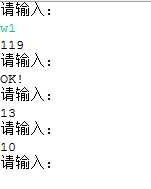标签:.com inf 有一个 输入流 输入 system.in inpu 程序 ==
System.in读取标准输入设备数据(从标准输入获取数据,一般是键盘),其数据类型为InputStream。方法:
int read() // 返回输入数值的ASCII码,,该值为0到 255范围内的int字节值。若返回值为-1,说明没有读取到任何字节读取工作结束。
int read(byte[] b) // 读入多个字节到缓冲区b中,返回值是读入的字节数
1 package InPackage; 2 3 /** 4 * System.in.read()返回值为输入数值的ASCII码,该值为0到 255范围内的int字节值 5 * 如果因为已经到达流末尾而没有可用的字节,则返回值 -1。 6 */ 7 public class Intest1 { 8 public static void main(String args[]) throws java.io.IOException 9 { 10 int a=0; 11 System.out.println("请输入a:"); 12 a=System.in.read(); 13 System.out.println("a="+a); 14 System.out.println("(char)a="+(char)a); 15 } 16 /** 17 * 假设我们输入a为1 18 * 输出结果为: 19 * 请输入a: 20 * 1 21 * a=49 22 * (char)a=1 23 */ 24
有一个有意思的问题是:当我们输入一个字符,System.in.read()会读取几个字符呢?
1 package InPackage; 2 3 import java.util.Arrays; 4 5 /** 6 * 当我们输入一个字符,System.in.read()会读取几个字符 7 * 我们从运行结果可以看出是三个 8 * 假设我们输入一个字符,那么它会接着读取该字符后面的/r和/n 9 */ 10 public class Intest2 { 11 public static void main(String[] args) throws Exception { 12 int[] x = new int[6]; 13 Arrays.fill(x, 5); //Arrays.fill(int[] a,int b)方法用于给数组中的每个元素赋值 14 for (int i = 0; i < x.length; i++) { 15 System.in.read(); 16 System.out.println(x[i]); 17 } 18 } 19 /** 20 * 假设我们输入值分别为1,2 21 * 输出结果: 22 * 1 23 * 5 24 * 5 25 * 5 26 * 2 27 * 5 28 * 5 29 * 5 30 */ 31 }
System.in.read()每次只是读取一个字符,但它多读取的是哪几个字符呢?
import java.io.IOException; /** * System.in.read()每次只是读取一个字符 * 按下回车键代表了两个字符\r\n,\r的ASCII码值是10,\n是13。另外,1对应的ASCII是49 */ public class Intest3 { public static void main(String args[]) throws IOException { for (int j = 0; j < 5; j++) { System.out.println("请输入:"); char c = 0; c = (char) System.in.read(); if (c == ‘1‘) { System.out.println("OK!"); } else { System.out.println((int) c); } } } }
对于上面的程序,我们首先输入的是w1,结果如下图所示:

可以看出程序还没有执行完,阻塞于最后一个“请输入:”,此时我们再次输入1,程序执行完成,结果如下图所示:

如何让System..in.read()读入一行数据呢?
1 package InPackage; 2 3 import java.io.IOException; 4 5 public class Intest4 { 6 public static void main(String args[]) { 7 int b; 8 try { 9 System.out.println("请输入:"); 10 while ((b = System.in.read()) != -1) { 11 System.out.print((char) b); 12 } 13 } catch (IOException e) { 14 System.out.println(e.toString()); 15 } 16 } 17 /** 18 * 输出结果: 19 * 请输入: 20 * test 21 * test 22 */ 23 }
1 package InPackage; 2 3 import java.io.BufferedReader; 4 import java.io.DataInputStream; 5 import java.io.InputStreamReader; 6 7 /** 8 * 通常情况下,你会用readLine( )一行一行地读取输入, 9 * 因此要把System.in包装成BufferedReader。但在这之前还得先用InputSteamReader把System.in转换成Reader。 10 * BufferedReader in = new BufferedReader(new InputStreamReader(System.in)); 11 * in.readLine()返回值为String类型 12 * 13 */ 14 public class Intest5 { 15 public static void main(String args[]) throws java.io.IOException { 16 System.out.println("请输入整数:"); 17 BufferedReader reader = new BufferedReader(new InputStreamReader(System.in)); 18 //或者这么写也可以:DataInputStream reader = new DataInputStream(System.in); 19 int a = Integer.parseInt(reader.readLine()); // 这样得到的是String类型的,需要转换为需要的类型 20 System.out.println("a=" + a); 21 int sum = 0; 22 for (int i = 0; i <= a; i++) 23 sum += i; 24 System.out.println(sum); 25 } 26 /** 27 * 假设我们输入a为100 28 * 输出结果为: 29 * 100 30 * a=100 31 * 5050 32 */ 33 }
public int read(byte[] b) throws IOException又是怎么使用的呢?
1 package InPackage; 2 3 /** 4 * public int read(byte[] b) throws IOException 5 * 从输入流中读取一定数量的字节,并将其存储在缓冲区数组 b中。 6 * 返回值为:以整数形式返回实际读取的字节数。 7 * 如果 b的长度为0,则不读取任何字节并返回 0; 否则,尝试读取至少一个字节。 8 * 如果因为流位于文件末尾而没有可用的字节,则返回值 -1;否则,至少读取一个字节并将其存储在b中。 9 * 10 */ 11 public class Intest6 { 12 public static void main(String args[]) throws Exception { 13 byte[] barray = new byte[5]; 14 System.out.println("请输入:"); 15 System.in.read(barray); 16 for (int i = 0; i < barray.length; i++) { 17 System.out.println((char) barray[i]); 18 } 19 } 20 }
转载:https://www.cnblogs.com/ningvsban/p/3593817.html
标签:.com inf 有一个 输入流 输入 system.in inpu 程序 ==
原文地址:https://www.cnblogs.com/wjlwo2ni/p/10551351.html